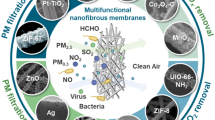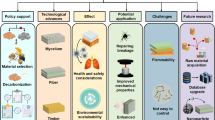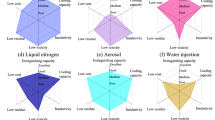Abstract
The smoke characteristics of the organic–inorganic hybrid polymer materials (SSP) used in the building decoration were investigated by smoke density test (SDT) and cone calorimeter-Fourier-transform infrared spectroscopy (CC-FTIR). The effects on the organisms were further studied by mice experiments. The SDT results showed that the absorbance of SSP was much lower than that of the polyurethane with or without fire retardant. The CC-FTIR results indicated that the toxic components, such as CO, CO2, HCN and NOx, in the smoke of SSP were kept at the low level. In the mice experiments, no more than two mice died under 300 °C. Although more mice died when the heating temperature increased to 600 and 900 °C, the dead number was lower than that of polymer materials. Furthermore, the cycle number also showed the good healthy condition of the mice in the experiments about SSP.

















Similar content being viewed by others
References
http://www.ctif.org/sites/default/files/ctif_report22_world_fire_statistics_2017.pdf. Accessed 06 Sept 2017.
http://news.xinhuanet.com/politics/2016-01/18/c_128640204.htm. Accessed 06 Sept 2017.
An W, Sun J, Liew KM. Effects of building concave structure on flame spread over extruded polystyrene thermal insulation material. Appl Therm Eng. 2017;121:802–9.
Liang HH, Ho MC. Toxicity characteristics of commercially manufactured insulation materials for building applications in Taiwan. Constr Build Mater. 2007;21:1254–61.
http://www.abc.net.au/news/2017-06-15/london-tower-fire-how-did-grenfell-blaze-spread-so-quickly/8620026. Accessed 30 June 17.
Xu W, Wang G. Influence of thermal behavior of phosphorus compounds on their flame retardant effect in pu rigid foam. Fire Mater. 2015;40:826–35.
Jin FL, Li X, Park SJ. Synthesis and application of epoxy resins: a review. J Ind Eng Chem. 2015;29:1–11.
Fire Statistics United Kingdom, Department for Communities and Local Government, London, 2007.
Cheng JJ, Qu WJ, Sun SH. Mechanical properties improvement and fire hazard reduction of expandable graphite microencapsulated in rigid polyurethane foams. Polym Compos. https://doi.org/10.1002/pc.24786.
Hu XM, Wang DM, Wang SL. Synergistic effects of expandable graphite and dimethyl methyl phosphonate on the mechanical properties, fire behavior, and thermal stability of a polyisocyanurate–polyurethane foam. Int J Min Sci Technol. 2013;23:13–20.
Hu XM, Wang DM. Enhanced fire behavior of rigid polyurethane foam by intumescent flame retardants. J Appl Polym Sci. 2013;129:238–46.
Pragyan M. A critical review: the modification, properties, and applications of epoxy resins. Polym Plast Technol. 2013;52:107–25.
Hu XM, Zhao YY, Cheng WM. Effect of formaldehyde/phenol ratio (F/P) on the properties of phenolic resins and foams synthesized at room temperature. Polym Compos. 2015;36:1531–40.
Mehdi J. Recent progress in the chemical modification of syndiotactic polystyrene. J Polym Chem. 2014;5:2663–90.
Wiacek M, Wesolek D, Rojewski S, Bujnowicz K, Schab-Balcerzak E. Halogeno-modified polystyrene: monomer reactivity ratios, thermal behaviour and flammability. Polym Int. 2014;63:1982–90.
Chen XL, Ma C, Jiao CM. Synergistic effects between iron-graphene and melamine salt of pentaerythritol phosphate on flame retardant thermoplastic polyurethane. Polym Adv Technol. 2016;27:1508–16.
Cheng WM, Hu XM, Xie J. An intelligent gel designed to control the spontaneous combustion of coal: fire prevention and extinguishing properties. Fuel. 2017;210:826–35.
Chen XL, Ma C, Jiao CM. Enhancement of flame-retardant performance of thermoplastic polyurethane with the incorporation of aluminum hypophosphite and iron-graphene. Polym Degrad Stabil. 2016;129:275–85.
Liu J, Peng S, Zhang Y, Chang H, Yu Z. Influence of microencapsulated red phosphorus on the flame retardancy of high impact polystyrene/magnesium hydroxide composite and its mode of action. Polym Degrad Stabil. 2015;121:208–21.
Cheng WM, Hu XM, Zhao YY, Wu MY, Hu ZX, Yu XT. Preparation and swelling properties of poly(acrylic acid-co-acrylamide) composite hydrogels. e-Polymers. 2017;1:95–106.
Liu J, Zhang Y, Peng S, Pan B, Lu C. Fire property and charring behavior of high impact polystyrene containing expandable graphite and microencapsulated red phosphorus. Polym Degrad Stabil. 2015;121:261–70.
Wu Z, Yang L, Zhan J, Chen Y, Zhou X. Experimental study on polystyrene with intumescent flame retardants from different scale experiments. Fire Mater. 2014;40:18–26.
Hu XM, Wang DM, Cheng WM, Zhou G. Effect of polyethylene glycol on the mechanical property, microstructure, thermal stability, and flame resistance of phenol-urea-formaldehyde foams. J Mater Sci. 2014;49:1556–65.
Hu XM, Zhao YY, Cheng WM, Wang DM, Nie W. Synthesis and characterization of phenol-urea-formaldehyde foaming resin used to block air leakage in mining. Polym Compos. 2014;35:2056–66.
Cheng JJ, Zhou FB. Flame-retardant properties of sodium silicate/polyisocyanate organic-inorganic hybrid material. J Therm Anal Calorim. 2016;125:913–8.
GB/T 8627-2007, Test method for density of smoke from the burning or decomposition of building materials.
GT/T 20285-2006, Toxic classification of fire effluents hazard for materials.
Liu L, Hu J, Zhuo J, Jiao C, Chen X, Li S. Synergistic flame retardant effects between hollow glass microspheres and magnesium hydroxide in ethylene–vinyl acetate composites. Polym Degrad Stabil. 2014;104:87–94.
Funding
This work was supported by the Doctoral Found of QUST.
Author information
Authors and Affiliations
Corresponding author
Rights and permissions
About this article
Cite this article
Cheng, JJ., Sun, Sh. Investigation on the fire hazard of hybrid polymer materials based on the test of smoke toxicity. J Therm Anal Calorim 135, 2347–2357 (2019). https://doi.org/10.1007/s10973-018-7306-8
Received:
Accepted:
Published:
Issue Date:
DOI: https://doi.org/10.1007/s10973-018-7306-8




